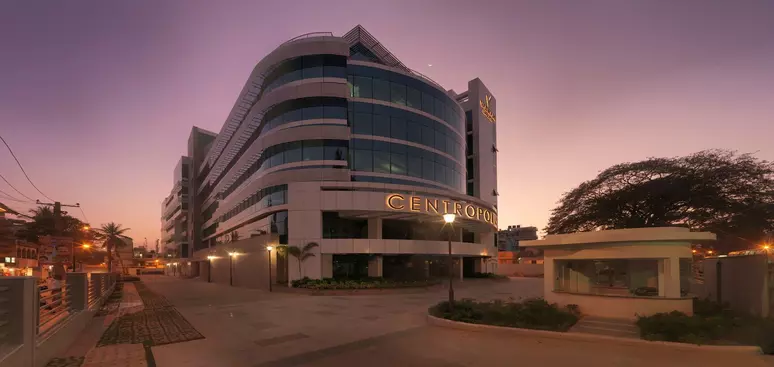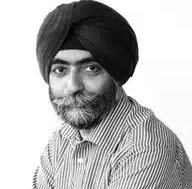In a rendezvous with WFM, Architect Arunjot Singh Bhalla, Managing Director, RSP Design Consultants India Pvt. Ltd, spoke about his company’s Indian operations, evolving designs and trends in façades and fenestration, and much more.
WFM:Please give us a brief introduction of your firm and few of your recently completed important projects?
Arunjot Singh Bhalla: RSP Design Consultants India Pvt. Ltd is an International Design Company with close to 60 years of successful track record in a diversified range of projects. The Indian operation of RSP Design was established in February 1996 with Bangalore as its main office and over the years we have forged a competent team of over 370 professionals in 5 offices across India. As Project Consultants, RSP Design provides multi-disciplinary Design Services including master planning, building planning & design, interiors, MEP and landscape design services for a wide range of projects in the institutional, residential, commercial, IT parks, hospitality, healthcare, retail and industrial sectors.
Some of our recently completed notable projects include the corporate campus assignment for Cisco Systems in Bangalore. Commercial offices for Embassy & Prestige Group, Forum Malls in Hyderabad & Mangalore, 500-bed hospital for Jaypee group in Noida, Oberoi Hotel in Gurgaon, Aloft Hotel in Bangalore, Inter-globe Corporate offices in Gurgaon, Interior projects for Wells Fargo and Britannia amongst others. In addition to the above, we have completed residential developments for Prestige, Vaswani & The Olympia Group.
WFM: Tell us about the use of glass in facades of buildings.
Arunjot Singh Bhalla: The facade is a very important component of any building. And in the truest sense, facade or “the skin” is a climate moderator.It has to respond to both to the external environment as well as internal requirements. At the same time, the façade can be an element of visual focus, enabling a building to be iconic and timeless.
The use of glazing in facades also enables a faster pace of construction as elements of glass are pre-fabricated and quickly assembled at site. The same work in masonry, plastering and block work is typically more time-consuming.
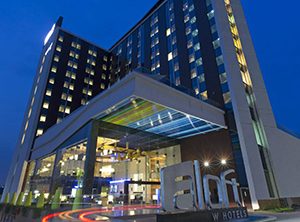
WFM: What is the trend and how is it evolving?
Arunjot Singh Bhalla: The current trends are evolving towards the use of granite metal and stone materials as well as glass in a unitized system. There is a focus on ensuring that façade design complies with and responds to high levels of sustainable parameters as well.
WFM: Clients prefer glass façade for commercial and IT buildings, but not for residential projects. Why?
Arunjot Singh Bhalla: This is typical for our projects in India and the primary reasons relate to privacy and in some instances to customer perceptions and concerns about safety. Cost and budget parameters can also play a part.
WFM: Double facade is being used in many buildings in west for thermal control, but not so popular in India. Why?
Arunjot Singh Bhalla: The primary reason in my opinion is the higher cost for double glazed systems. However double glazing provides significant benefits in reduction of heat gain, particularly for building aspects exposed to direct solar incidence. This is even more pertinent for the Northern regions of the country such as the NCR. Adoption of double glazing in these areas actually has long term cost saving benefits with respect to overall air conditioning costs within the building. I am sure as more client groups become conversant with this aspect, we will see increased usage of double-glazed facades.
WFM: Other than glass, have you found any new materials used abroad which could be used effectively in India?
Arunjot Singh Bhalla: Internationally façade designs adapt range of materials within an overall façade system including stone materials, laminated wood and other finishes. We are already seeing the adoption of similar materials in the Indian context as well.
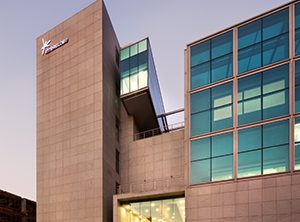
WFM: How are you looking at the plasticity of the material to mould the facade and then the colours and concepts?
Arunjot Singh Bhalla: Façade technologies have made significant strides and provide designers vast opportunities for creating “plastic” forms and shapes, complex geometries and volumetric play which can be eye-catching yet functional.
WFM: Tell us about your trendy projects in India?
Arunjot Singh Bhalla: What is “trendy” today is likely to be not trendy tomorrow. Our design philosophy, therefore, focuses on creating timeless solutions in a holistic manner. Few of our projects in India that established new directions and design benchmarks in their immediate context include The International Technology Park at Bangalore, the Microsoft Campus at Hyderabad, The Oberoi Hotel at Gurgaon and a number of our other projects currently under completion.
WFM: On quality control (QC) what all criteria you look for while choosing glass for various projects?
Arunjot Singh Bhalla: In keeping with RSP’s commitment to sustainability initiatives, the key criteria for glass selection are determined by energy efficiency and benchmarks defined for the project for delivering green buildings that are environment-friendly and cost-effective in their operation and use.
Accordingly, the Visible Light Transmission (VLT) percentage of the selected glass is to be balanced with the solar control properties, namely Shading Coefficients (SC). Newer improved coated glass products that are being produced locally provide for good light transmission (VLT 40-60 per cent) while limiting solar radiation (SC 0.20 – 0.25) and are installed as Double Glazed Units (DSU’s) for high-performance applications. From a visual perspective lower moderate reflectance, neutral appearance and natural colour rendering (high CRI) are preferred.
Quality is determined by careful processing of glass to ensure uniform tempering/heat strengthening of the panel for safety while minimizing distortion due to bowing of the glass surface during tempering.
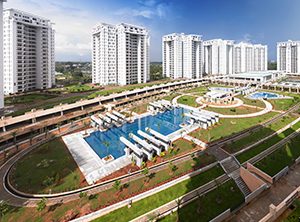
WFM: Talking about fenestration, the trends are changing. Could you please provide insight on this?
Arunjot Singh Bhalla: Fenestration choices, especially for Residential Applications thus far have been limited to basic aluminium or UPVC Systems. However, with the demand for premium Residential products, newer systems which have good thermal insulation properties and greater functionality in operation are being introduced though cost for imported systems need to be balanced against project budgets.
Greater market appreciation for quality/performance would entail more options from manufacturers and rationalization of price per unit installed.
WFM: In India Building designers generally do not prefer UPVC for their projects; atleast for upper or upper middle size residential projects. What is your observation on this?
Arunjot Singh Bhalla: For this segment of projects good quality timber procurement and availability of seasoned wood always remain a challenge. From the end user perspective UPVC is seen as being “plastic”. Of late, however people are beginning to appreciate the low maintenance indices UPVC inherently affords.
WFM: How important is the positioning of Windows?
Arunjot Singh Bhalla: Sizing and positioning of the windows are very important. It depends on how and where does it open to, size and volume of the project. If positioned wrongly, even the placement of furniture inside will get affected. It depends on functional orientation of the room and purpose of getting best views, light and ventilation; for e.g., in a residential project a bed room window, opening direction would be different from a living room or a kitchen. While windows form an important part of the overall aesthetics of the facade functionality plays an important part as well.
WFM: What are the hurdles faced by the Building Designer while collaborating the view of the facade consultant, fabricator, contactors, etc?
Arunjot Singh Bhalla: I think ‘hurdles” is too strong a word. A successful designer is one who takes on board all inputs from façade consultants, fabricator and contractors with respect to availability of materials, technology, capability & budget and successfully modulates these to meet both design intent and client requirements.
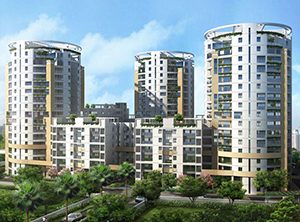
WFM: What advice would you give the fabricators/ manufacturers of facade materials, doors & windows, contractors and consultants in India in terms of the following: Upgrading knowledge, commercial variability, quality control and installation?
Arunjot Singh Bhalla: There are good quality contracting agencies, fabricators and manufacturers available in India. As continuous improvement is required it is important that all agencies maintain exposure best in class, quality standards being adopted internationally and ensure dissemination of knowledge at all levels within the industry through training sessions and works shops. It is also important that designers continue to challenge fabricators through improved creative design standards and performance parameters.
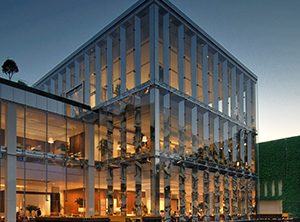
Located adjacent to the Trident Hotel, in Gurgaon’s Udyog Vihar District, Designed by RSP Design, the 202 room luxury business hotel caters to the needs of this fast growing extension of the National Capital Region. In addition to a luxury retail component, this hotel also comprises restaurants, convention and business facilities and a spa cum health club.
As a design concept, the hotel has been envisaged as an oasis of calm and reflection amidst the urban sprawl within which it was situated – one that would be presented to the guest as a rare experience standing apart from the commonality of the street outside.
From the beginning, the designers were clear that this ‘rare experience’ would be symbolized by a grand architectural feature that would serve as the experiential focus of the hotel.
Taking off from the idea of a jewel as the perfect metaphor for the type of guest experience being presented, the architects designed the hotel lobby as a huge shimmering stainless steel cage encased in sparkling extra clear glass. This ‘Jewel Box’ would house the hotel reception and restaurants and would be surrounded by abundant expanses of reflecting pools. Framed by two solid blocks – one housing the guestrooms and the other serving as a retail promenade – this Jewel Box would serve as the heart of the design, around which all else would be arranged.
Arriving off the street, the guest is driven up a long and winding cobbled driveway flanked by lush greenery, up to the roof the hotel building. This drive – as an experiential anti-thesis to all that the guest has gone through on the streets outside – is designed to awaken his senses and place him in a mood of anticipation to the experience awaiting him on the roof. Receiving only hinted glimpses through the foliage as he drives up, it is only when he arrives to the motor court on the hotel roof that he will be confronted by full spectacle and grandeur of the Jewel Box.
Entering the hotel lobby, the guest then takes elevators to go down into the hotel, to access the restaurants, lounges and business facilities available. All these spaces are arranged with views of large reflecting pools arranged at various levels around the Jewel Box.
Set before a 35,000 sq ft reflecting pool, the ‘Jewel Box’ comprises a three storey structure encased in a cage of diamond shaped columns and beams clad in mirror finish 1.5mm thick grade 304 stainless steel sheets – and then sheathed with tall panels of extra clear, low-iron glass. The glass is fixed to the column and beam cage with custom made galvanized steel patch fittings which are then covered with the same mirror finish stainless steel diamond shaped cappings. The diamond shapes of the beams and columns allow the glass panels to cover the structure from the plinth to the roof without the need for spandrels or shadow-boxes.
The Jewel Box houses the main hotel lobby on its topmost floor, with a lounge bar on the middle level, and the main hotel restaurant on the lowest level. In order to ensure that none of the glazing joints are visible from inside these spaces, each floor is spanned by a single glass panel – the hotel lobby floor featuring panels that are 8m tall and fixed on 8 patches – while vertical joints are hidden behind the vertical members of the jewel box cage. To heighten this effect of a glass façade that cannot be seen by the occupants of the building, the Jewel Box also features extra clear low-iron glass that diminishes internal reflections. Pipes embedded in the floor run along the glazing line, blowing a continuous stream of hot air on the glass panels to ensure that they do not catch vapour condensation even during summer months.
At the rear of the hotel lobby is another lobby – a smaller version of the Jewel Box – serving the banquet and convention facilities in the hotel. This sits as a glass box on the roof of the hotel which allows occupants to descend down into the convention and banquet halls within the hotel by means of grand staircases. At the entrance of the hotel complex are two retail pavilions located on a symmetrical axis to the main Jewel Box. Each of these are designed as glass cubes suspended within a cage composed on stainless steel clad portals, and form a visual frame for the Jewel Box when viewed from the entrance of the hotel.
Designed by RSP Design , and façade consultants Aurecon of Singapore, the Jewel Box Façade is designed to create a guest experience holistically planned to reflect the value and originality of The Oberoi brand.
Quick Facts
Project: The Oberoi
Location: Gurgaon
Client: The Oberoi Group
Consultants:
- Design Consultant: RSP Architects, Planners & Engineers (Pte) Ltd, Singapore in association with RSP Design Consultants (India) Pvt. Ltd., Bangalore
- Façade Consultants: Aurecon Facades, Singapore
- Interior Designer: Lim Teo Wilkes, Kuala Lumpur
- Landscape Designer: P Landscape Associates, Bangkok
- Lighting Consultant: Project Lighting Design, Singapore
- Structural Consultant: RSP Architects, Planners and Engineers, Singapore with Vijay Rewal Associates, New Delhi
- MEP Consultant: Squire Mech, Singapore with SANELAC Consultants, New Delhi
Materials used for façade: 15-19mm thick low-iron (extra clear) tempered heat soaked glass; 1.5mm thick Stainless Steel grade 304 mirror finish cladding; Custom-made hot-dipped galvanized steel Patch Fittings; Dow Corning 789 Grey Colour Weather Sealant Commencement Date: June 2007 Completion Date: April 2011 Area: 727,000 Sq ft Cost: NA
